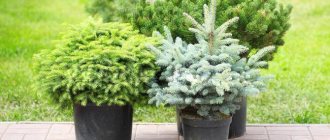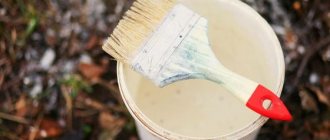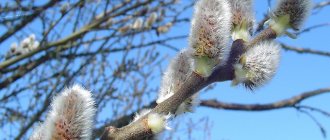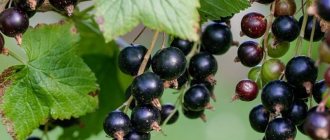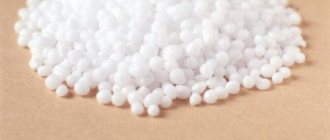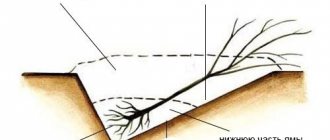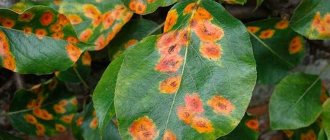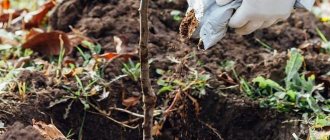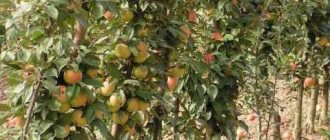All work in the garden should begin with freeing the branches from ice or snow. If the branches have already sagged, it is necessary to build supports for optimal support. In areas with a slope, snow banks must be made across the slope to drain melt water. You should also stock up on melt water. You should start cleaning the garden immediately after the snow has melted. You should collect old leaves and other debris, and get rid of weeds if present.
Thorough inspection of the area
Before performing any manipulations at lightning speed, you need to sensibly and slowly assess the scope of the work. Naturally, each stage needs special attention, but if there are visible problems, it is necessary to prepare in advance for their solutions.
The first thing that catches your eye is the degree of flooding of the area, how heavy and heavy the snowfalls were, the melting of which the earth is unable to quickly cope with. If possible, try to expand the “puddles”, thereby increasing the area of the area with water, and the earth will be able to quickly absorb what is left from prolonged snowfalls.
You need to carefully examine all the trees and their “inhabitants”. It is possible that a hollow has appeared or insects have infested. The bark can be damaged by rodents. Sunburn is rare, but it cannot be completely ruled out. Pay attention to any branches that have been broken by the wind or the weight of snow.
After such an “audit”, every gardener will clearly understand where he needs to start and what he is preparing for. It also helps not to miss details and not regret the consequences.
What to do if the bark bursts
Significant differences in day and night temperatures often cause cracking of the upper layer of bark. At the sites of cracks, holes in the bark are formed. They can be detected either visually or by tapping the trunk with a wooden object.
A dull sound will clearly indicate to you where the bark is leaving. To provide first aid to a tree, you need to wait for a dry sunny day, prepare a garden decoction and, having previously cleaned the damage, tightly tie the hole around the hole with fabric material soaked in garden decoction. If it is still early spring, then it is better to additionally insulate the damage with burlap and film.
Snow removal
For perennial plants, snow is a kind of “blanket” that not only reliably covers, but also warms from severe frosts. Unfortunately, snow does not have exactly the same effect on trees, since the abundant adhesion of wet snow forms huge mounds, which during glaciation or melting increase the mass several times, causing splitting or breaking off good branches. Try to pay attention to the crowns throughout the winter; if they are heavily snowed, don’t be lazy and chicken out of them.
With the beginning of spring, it is necessary to help tree trunks free themselves from heavy icing, because the period of “awakening” has arrived, but it is impossible to bring it to life.
Watering fruit trees and snow retention when caring for the garden
During the summer, fruit trees in a young garden need to be watered 3-5 times, depending on the properties of the soil and the amount of precipitation. On lighter soils, watering should be done more often than on heavier soils. Watering is especially necessary in the first half of summer (May - June), when trees grow most vigorously.
In young gardens, especially in open areas, in order to accumulate moisture and insulate the soil, it is necessary to carry out snow retention with shields, snow banks and other means for snow retention; planting curtains of berry bushes - currants or gooseberries in rows of trees - with a distance between bushes of 2 m is of great importance. Berry bushes can be planted either in each row, or after 1-3 rows, depending on the protection of the garden and its size.
It is also necessary to take measures to retain spring melt water by installing snow dams, embanking individual areas on light slopes, and on steeper slopes - mulching the snow with straw, manure and other materials, under which water from slowly melting snow will not flow off, but will be absorbed by the soil .
Formation of the plant crown
This necessary care procedure, carried out in the country before the start of sap flow, slows down the growth of unproductive shoots, due to which nutrients flow to the fruiting shoots, which contributes to a bountiful harvest. Most often, tree pruning is performed in February - March. When performing this type of work, not only the desired crown is formed, but also excess, damaged, dry and diseased branches are removed. During spring pruning, be sure to remove dead and old branches. If the winter was very cold and damage on the branches is clearly visible, we carry out pruning a little later, namely in April, when it is possible to identify severely damaged shoots by the visible surviving buds and remove them. If it becomes clear that there are very few living buds, then we carry out gentle pruning, trying to preserve as many fruit buds as possible.
If the generative organs are overweight and their growth is weakened, intensive pruning should be performed by thinning and shortening the shoots. Thanks to this pruning, the plant will be more leafy and the fruits will be larger. During pruning, we pay special attention to treating the cuts with garden varnish. Do not leave open wounds on trees and bushes. Through them, various pathogens can penetrate into the plant.
When forming the crown and pruning, it is necessary to clearly distinguish which shoots are productive and which are not. The easiest way is to determine which branch will benefit the buds. Thus, the fruit buds of almost all fruit and berry plants are thicker, rounder and shorter. Leaf buds are elongated and thin. If there are no fruit buds on the branch or there are very few of them, then you can safely say goodbye to it. If the shoot is strewn with fruit buds, it is better to look for a replacement in the form of another unproductive shoot, so as not to deprive yourself of several additional fruits in the future.
Garden care: how to prune fruit trees correctly
Young orchards in central Russia were usually planted with trees formed according to the type of five-legged or tiered crown. Most of the planting material with this formation is still produced by nurseries.
The formation of the crown is based on the tiered arrangement of branches. When planted in the garden, two-year-old seedlings must have five strong lateral branches (first tier) and a vertically directed continuation shoot. The main branches usually develop from buds located nearby on the trunk, less often through one (whorled crown).
The second tier of branches is laid on the guide in the second or third year after planting in the garden at a distance of 40-50 cm from the first. The side branches of the second tier should be in the spaces between the branches of the first tier. For the second tier, usually three branches are left, thinning them out through one internode.
If desired, the third tier can be laid in the same way. Three-year-old seedlings released from the nursery usually have a second tier of crown already established.
In the next 2-3 years, pruning is done mainly to regulate the strength of development of individual branches. The upper branches are pruned more heavily than the lower ones. The lateral branches between the tiers and skeletal branches are cut short or pinched, and when thickened, they are cut out completely.
Compared to a tiered system, tiered pruning of trees in the garden has a number of disadvantages:
- whorled arrangement of the main branches of the first tier, which does not ensure their strong fusion with the trunk, therefore, under the weight of the harvest, the branches may break (if supports are not placed), which reduces the durability of the tree;
- crowding of branches, creating less favorable conditions for lighting and air access to the internal parts of the crown, as a result of which the central conductor and main branches develop poorly and some of them often die. In some varieties (Anise, Antonovka vulgaris, etc.) these shortcomings are expressed to a lesser extent.
A five-year-old tree formed according to a five-legged (tiered) system.
A relatively stronger five-legged crown is obtained by thinning the lateral branches on the trunk by cutting them out one or two at a time.
In order to properly prune fruit trees, as experienced gardeners advise, you need to start this activity in early spring before the sap begins to flow, since pruning a tree that has begun to grow can weaken its development.
To avoid thickening of the crown, branches should be cut to the outer bud. In cases where the branch strongly deviates downward or is directed to the side, pruning should be done either on the inner bud or on the lateral one.
Tree pruning
It would seem that the more branches there are on a tree, the richer the harvest can be expected this year. It's a delusion! Only strong, young and fruit-bearing branches are capable of producing a bountiful harvest, which does not in any way affect the total number of branches.
Many people are sure that trees need to be pruned in the fall, but this is far from true. The tree will be able to survive the winter with an abundant “bouquet”, but it will not continue to grow, develop and fully give birth. Therefore, it is important to prune in March - April, since with the beginning of awakening, all the “rough” work must be completed.
Remember, pruning is not a luxury, but a necessity, since not only does all development and growth improve, but also a crown of the correct shape and size is formed. Moreover, the yield will automatically increase, since weak and old branches are not able to withstand heavy harvests; accordingly, the fruits grow small and absolutely not juicy, because they did not receive adequate nutrition from the branches.
Trimming order
- We remove unproductive shoots and old branches;
- we cut out all the processes directed downward;
- We remove young shoots that interfere with the growth and development of other branches.
- We treat the cut areas with garden varnish.
Pruning various fruit crops has its own nuances:
- Apple and pear trees have one trunk and branches that extend from it at an obtuse angle.
The main thing for these crops is to prevent thickening of the crown, since this greatly affects the yield and size of the fruit.
- The shape of a plum most often resembles a bush, so when pruning it, forming a cup-shaped crown, we remove the central conductor. Every year we cut out old branches and shoots that are close to each other.
- Cherry branches cannot be shortened, since its fruit buds are located only at their ends. We cut out old branches completely only if the goal is to thin them out.
- Spring pruning of apricots and peaches should be very careful. To form a compact crown, the top of these crops is cut off. We also remove shoots growing low or drooping.
- There are differences in pruning berry bushes depending on the crop being grown (for example, raspberries versus grapes). But the principle of shaping and pruning is almost the same as for trees: removing old, dry, damaged and diseased branches. To maintain the shape of the crown, the outer shoots are shortened to the desired shape. The middle of the bush is thinned out especially carefully, since a heavily thickened plant produces a small harvest.
Soil care in the garden: processing techniques
Agrotechnical measures for caring for the soil in a young garden should be aimed at increased growth of trees in the first half of the growing season and at the timely completion of growth with full ripening of the wood and its hardening for the winter - in the second half of the growing season. To do this, it is necessary to create the best conditions for water supply and nutrition of fruit trees from early spring to the end of summer.
The soil in a young garden must be kept under black fallow. This soil cultivation technique promotes the accumulation and retention of moisture in the soil, the penetration of air into it, which promotes the accumulation of nutrients and their better absorption by plants. To do this, every year in the fall, the row spacing of the garden, not occupied by perennial crops, should be plowed to a depth of 18-20 cm, leaving the arable land unharrowed; plowing the row spacing should be carried out in the longitudinal and transverse directions, which reduces the area of digging near the tree trunks, or - one year in the longitudinal direction, and the other - in the transverse.
To retain moisture on slopes, plowing is carried out across them.
Unplowed strips and trunk circles are dug up to the same depth.
To avoid damage to the root system, digging near trees should be done to a shallower depth (8-10 cm), and when digging, the shovel should be placed with its edge facing the tree. Garden forks are very convenient for digging.
The diameter of the treated trunk circle should be approximately 1-1.5 m larger than the diameter of the crown; annually when digging, it should be increased by an average of 0.5 m.
In order to preserve moisture in the soil, use it economically and control weeds, several surface loosening is carried out in the spring and summer. In early spring, depending on the degree of readiness of the soil for cultivation, the row spacing is loosened with an ordinary harrow. You can also use a disc harrow for this purpose.
In case of severe compaction of the soil after snow melts, which is usually observed on heavy loamy and clay soils, it must be loosened with a cultivator or harrow and then harrowed, without leaving large clods.
Simultaneously with loosening the row spacing, tree trunk circles and row strips of both the main planting and compactor crops are hoeed and harrowed with a rake.
In case of strong floating and compaction of the soil, tree trunk circles and row strips need to be dug up again and at the same time the surface should be leveled with a rake. After loosening, the tree trunk circles are mulched with manure, small straw, wood leaves and other materials to a thickness of 6-10 cm. This event is especially useful where it is not possible to carry out systematic watering. Mulching has a beneficial effect not only on preserving moisture in the soil, but also on preserving its structure, and also creates more favorable soil nutrition conditions for fruit plants.
When digging in autumn, mulching materials should be mixed with the soil.
During the spring-summer period, as the soil surface compacts, crust forms after rains and weeds appear, it is necessary to perform another 4-5 loosening of both tree trunk circles and strips, and row spacing, using hoes, horse-drawn or tractor cultivators, hullers and other tools. .
By the end of summer, with significant soil moisture and the observed delay in tree growth, soil loosening should be stopped. In dry summers, when shoot growth has ceased normally, loosening continues until autumn.
Shrub pruning
Grape. Let's start with the fact that the bush is formed from 4 lashes, which extend from a short trunk. The shoots diverge horizontally, two in one direction, two in the opposite direction.
Next we need to select 4 young shoots that extend from the trunk. These are the ones we will use for rejuvenation. We mark these shoots with ribbons, after which we cut off all the old lashes.
Important! It is necessary to leave the annual shoots that bear fruit best. They are about the thickness of a pencil, and the buds are 15 cm apart. Raspberries and blackberries. It’s worth saying right away that we will not be talking about remontant varieties.
We start by removing all old shoots in early spring. They will die anyway, so we don't need them. Removal should be carried out before young branches appear. During the entire growing season, it is necessary to shorten the upper part of the shoots, since the berries are formed on side branches, and upward growth of the main branches reduces the yield. Pinching is carried out after the shoots have reached a length of 90 cm.
Pruning is also carried out if the shoots fall to the ground under the weight of leaves and berries. In this case, the main shoot should be shortened, otherwise the product will begin to rot after contact with the soil.
Clearing melting snow
In the spring, clearing trees and shrubs (as well as the greenhouse where I grow flowers and herbs) from heavy wet snow is especially important in March and April (in more northern latitudes). The danger of such spring snow lies in its heaviness, under the influence of which it can break or damage branches. Heavy wet snow poses the greatest danger to young plants. That is why during spring snowfalls, and even more so the danger of further icing of branches, it is necessary to shake it off from trees and bushes in a timely manner. If a thick layer of snow from the winter itself has been preserved on a summer cottage, with the onset of thaws it is necessary to throw away excess snow from the bushes.
Graft
Tree care in spring also includes grafting of fruit crops. It is performed until the kidneys swell. There are different ways, for example, cuttings into a split or behind the bark. They are prepared before severe frosts at the beginning of winter. Shoots of annual growths are suitable for grafting. The cuttings that are used for this may have 3 or 4 buds. The optimal cutting length is 30 cm. Usually, stone fruits are grafted first, and then pome crops. The grafting zone for young trees does not exceed 2 m above the soil, for shoots - 1.5 m from the trunk. For stone fruit crops, the cut diameter of the branch is about 3 cm, for pome crops – 5–6 cm. All work is carried out on the day of grafting. The junction areas between the cutting and the branch are wrapped with electrical tape, which is usually removed 3 or 4 weeks after the event or left until next spring.
How to properly care for garden trees
Caring for fruit trees in the photo
From the time of planting to the end of their life, fruit trees undergo a number of significant changes, different in each age period.
The first period is a period of enhanced development of vegetative (growth) parts. In the process of caring for garden trees in this phase, it should be taken into account that at this time the development of growth organs predominates over fruit ones. The number of the latter increases by the end of the period; Fruit buds are laid on them.
The second period is the period of fruiting. It is characterized by an increase in the number of overgrowing branches and fruit buds to the greatest extent, and a decrease in the growth of vegetative parts. This is the longest period in the life of a tree. It is especially important.
The third period is the period of mass death of skeletal (main) branches. It is characterized by a gradual weakening of fruiting and increased death of individual, mainly peripheral parts of the crown, with new shoots (tops) appearing on the older parts. When caring for fruit trees during this period, one must not forget that the peripheral part of the plant root system at this time begins to die, and new roots appear on the old ones closer to the base of the tree.
These periods are interconnected by a number of transition periods.
Berry plants also go through the same periods, only they proceed faster.
Fruit plants, like perennial woody plants, go through periods of vegetation and dormancy every year. During the growing season, a number of phenophases of growth and fruiting occur in a certain order.
Caring for fruit trees, as experienced gardeners advise, should take into account the main phenophases:
- Spring growing season: a) swelling of buds - growth and fruit; b) bud opening; c) separation of inflorescences and buds; d) the appearance of curled petals in the buds.
- Flowering - beginning, mass flowering, end of flowering.
- Fruiting is a phenophase from the beginning of fruit set until the onset of their removable maturity.
- Shoot growth is a phenophase, covering a period of increased growth and ending with the formation of the apical bud.
- Autumn vegetation - from the end of shoot growth to the end of leaf fall.
The dormant period in fruit plants lasts from the fall of the leaves in the fall to the swelling of the buds in the spring. It is associated with the cold season.
The duration of each period, as well as the passage of individual phenophases of fruit plants depend on the species and varietal characteristics, as well as external conditions and agricultural technology.
The care of trees in the garden in spring, summer and autumn is largely determined by the qualitative changes of plants in individual age periods. Separate techniques, or agricultural complexes, must be applied in accordance with the passage of phenophases and taking into account the breed and varietal characteristics of fruit plants in specific conditions.
Caring for fruit tree seedlings should be aimed at creating favorable conditions during the first period of fruit tree development, ensuring strong vegetative growth, formation of fruiting organs and accelerated entry into fruiting.
As practice shows, it is necessary to care for trees in the garden in such a way that all activities contribute to the timely annual passage of the growth phases of fruit plants during the growing season, their complete completion and sufficient hardening for the winter. This is achieved by using a system of agrotechnical measures for cultivating the soil in the garden and caring for fruit plants.
Prevention
Spraying
Disease and pest control is one of the most important agricultural practices. To do this, you can spray the branches with special solutions. This action is carried out in three stages. The first starts before the buds swell, the second - before flowering, the third - after 7 days. Important: when processing the garden, you must strictly follow the instructions for the product.
Whitewash
It can help prevent the sunburn that sometimes occurs from the bright rays of spring. Whitewashing also helps protect the trunk from pests. It must be carried out until the snow completely melts. It is better to whiten branches on a dry day. Before carrying out work, damaged trees should be prepared. To do this, you need to clean the trunk with a special brush, remove dead bark, growths, and lichens. Opened cracks should be disinfected with copper sulfate, then covered with garden pitch. Trees should be whitened immediately after all treated areas have completely dried.
Whitewashing - protection of garden crops
How to whitewash trees
Series of messages “Fruit trees”:
One tree at the age of 2-3 years requires 12-15 kg of fertilizers; every year the dose of fertilizer increases, i.e. for an eight-year-old tree, 40–50 kg of fertilizer is required, and older trees with a crown diameter of 6 m consume 120–160 kg of fertilizer.
The moisture-proof cup around the tree is filled with dry soil, compost, peat or plant debris in the spring, this prevents the rapid evaporation of moisture.
- Fertilizer doses depend on the fertility and composition of the soil in your region.
- Caring for fruit trees in the fall is the key to a long and comfortable life for fruit plants for many years to come. Therefore, you should start caring for your garden from the very beginning and throughout the life of the plants.
Treat fruit and berry crops with special preparations at least 3 times:
How to whiten fruit trees
- half a liter of copper sulfate;
- A healthy, blooming garden that brings a rich harvest largely depends on proper, high-quality care, especially in the spring. The time for the awakening of all living things is important and troublesome for gardeners. Carry out all work depending on weather conditions and climate zone.
- - for pome crops - 5-6 cm.
Garden care in winter and spring involves various activities. And each of them has its own deadlines. In winter, attention is paid to protecting trees from rodents. Mice and hares can damage tree bark. Annual and biennial crops are especially affected. The tree trunk is protected in the autumn. It is wrapped in various materials. At the end of winter, drugs are used that will repel rodents. They are placed around trees.
- In spring, trees need “medical” help more than ever.
- Part 1 - Sea buckthorn
- Mineral fertilizers are used taking into account the reaction of the soil, the age and fruitfulness of the tree. In the fall, when plowing the soil, phosphorus and potassium fertilizers are usually applied so that these substances are already absorbed during the growing season. With the onset of spring, nitrogen fertilizers are applied. You can also use combined fertilizers in autumn and spring, which gives a noticeable effect. During the growing season, nitrogenous fertilizers are applied additionally, and they are applied shallowly into the soil.
During the growing season, especially during dry periods, fruit trees are watered thoroughly and abundantly. Watering often, but little by little, is useless. Moisture does not reach the roots, remaining in the surface layer of the earth, on which a crust then forms. To retain moisture around the tree even before it begins to bloom, it is useful to lay peat, straw manure or grass in a layer of 5-10 cm.
- In the first year after planting, trees are watered 4-5 times per season at the rate of 20-30 liters per tree for each watering. In subsequent years, you can water less often, as needed, and increase the amount of water by 10 - 20 liters per each year of the tree’s life.
- Contents:
- before the growing season (bud swelling);
- Add 200 grams of wood glue to make the solution last longer on the wood.
Work in the garden begins with clearing the branches of the plantings from melted snow, if there was plenty of precipitation at the end of winter. The spring sun makes the snow loose and heavy and can easily break thin branches. To avoid this, shake it off. If the branches have already sagged and fallen, build supports to support them.
Protection from spring frosts
Spring frosts are the biggest problem, as they can destroy the crop at an early stage. Not only small gardens suffer from them, but also huge plantings, from which the products are supplied to many stores. Next, we will figure out how to overcome frosts, and whether it is possible to do this.
Artificial fog . This frost protection technology came to us from the USA. There, farmers purchase special installations that produce fog. It not only reduces visibility, but significantly increases the air temperature, which saves trees from a sharp drop in temperature. Of course, such installations are not cheap, but if you grow particularly valuable crops that will yield a lot of expensive products, then it makes sense to purchase such an installation in order to solve problems with unexpected frosts for ten years.
Fumigation of the garden . It’s worth saying right away that this method only saves from minor frosts. If the temperature drops below -5°C, smoking will not help your plants in the garden.
This is done as follows: at a distance of 4 meters from each bush or tree, a small “hut” is built, which consists of thick logs and thin twigs for lighting; wet leaves or straw are placed on top of the “hut”. After you set such a “structure” on fire, it will begin to smoke heavily, causing the garden to fill with smoke. Smoke increases the air temperature, so trees do not suffer from frost.
How else to fertilize garden trees
Fertilizers applied in liquid form have a faster effect on plants, so fertilizing should be done in relation to a certain phase of tree development.
Knowing how to fertilize garden trees, do not forget about the rates for applying mineral fertilizers: about 30 g of ammonium sulfate or 25 g of ammonium nitrate per bucket of water - 3-4 buckets per tree, organic - 3-5 buckets. Organic fertilizers are diluted at the following rate: a bucket of bird droppings with 8-10 buckets of water, a bucket of cow droppings with 4-5 buckets, a bucket of slurry with 3-4 buckets of water.
Fertilizers are poured into holes or grooves around the tree (along the periphery of the crown). Fertilizing is usually timed to coincide with rains, and in the absence of them, preliminary watering of the circles is carried out at the rate of 3-7 buckets of water per tree, depending on its age and the size of the trunk circle.
What other fertilizers can be applied to fruit trees to speed up their growth? This could be bird or cow droppings. Such dressings are prepared in advance as follows: pour water to the top into a large tub (tub) or barrel filled 14-1/3 full with clean droppings, cover the top, and then leave for 4-5 days to infuse. The resulting infusion is diluted when watering with the specified amount of water.
In irrigated gardens, fertilizing with mineral fertilizers is carried out simultaneously with watering. Fertilizers are scattered evenly over the entire irrigated area. After watering the fruit trees, the holes and furrows are leveled.
Plant protection from diseases
All plant remains that were not removed from the garden in the fall (leaves, fallen fruits, small twigs) are carefully removed and burned. Such plant residues are a source of spread of dangerous fungal and bacterial diseases. Therefore, as soon as the snow has melted, before the buds bloom on the trees and shrubs, we spray with various chemicals designed to prevent various fungal and bacterial diseases. For each tree or shrub, it is necessary to select appropriate drugs that prevent certain specific diseases of a given crop.
In case of severe infestations of trees and shrubs, it is preferable to use combination preparations that protect fruit and berry crops from most common diseases. We bring aqueous solutions of drugs to a certain concentration immediately before spraying so that their effectiveness does not decrease. Before spraying, carefully clean the trunk and skeletal branches of plants with a coarse cloth or brush. This procedure helps remove dead bark, moss and lichens that prevent the absorption of chemicals into the wood. Ideal for this procedure is a special hand sprayer that allows you to reach any branch on the tree.
Caring for garden trees in spring and summer: inter-row crops
The row spacing of young gardens, not occupied by berries and other fruit crops, can be used for sowing and planting vegetables, melons, row crops, herbs and other crops.
The row spacing of apple and pear trees can be occupied by these crops for 10-12 years, cherries and plums - for 4-6 years.
Inter-row crops are selected in accordance with planned targets, taking into account natural conditions, and the possibility of mechanized or horse-drawn processing.
In order to care for fruit trees correctly, as many years of gardening experience have shown, crops are selected for row spacing that, while developing well, not only do not interfere with the development of the main plantings, but, on the contrary, create relatively favorable conditions for their growth. The best interrow crops in a young garden in the middle zone are row crops - root crops and vegetables and melons (potatoes, carrots, beets, pumpkins). These crops require deep tillage and fertilization of the soil. Their development mainly takes place in the second half of summer. All this creates favorable conditions for tree growth and its timely completion at the end of the growing season.
Annual legumes (beans, broad beans, peas, lentils, etc.), which enrich the soil with nitrogen, can also be used when sowing them late in rows as interrow crops. On wetter or irrigated soils, perennial grasses (alfalfa and wheatgrass) can be introduced for a period of no more than two years. They improve the structure of the soil, enrich it with nitrogen and clear it of weeds.
You should not occupy the row spaces with industrial and grain crops, as they greatly deplete the soil. Among berry crops, raspberries should not be allowed as row spacing (compaction), as they strongly dry out the soil and clog it with offspring.
More efficient use of row spacing is possible by establishing proper crop rotation for interrow crops. Mineral fertilizers and manure, as well as soil care between rows, are determined by the requirements of each crop in the crop rotation.
- Author: admin
Rate this article:
- 5
- 4
- 3
- 2
- 1
(8 votes, average: 5 out of 5)
Share with your friends!
Lure
Fertilizing after the winter months is a mandatory rule in caring for perennials. Properly selected complementary foods will make up for the lack of minerals that promote foliage growth, flowering and fruit set. With the right concentration, the crop will actively develop and grow, regardless of age and membership in the fruit and berry family.
Root fertilizers
For complementary feeding, you can use both organic and mineral fertilizers. Today, stores offer a large selection of care products, including not only individual components, but also ready-made mixtures that combine complexes that combine up to 10 items at a time.
Minerals can be fed 2 times a year.
Organics are allowed no more than once every 2-3 years. Complementary feeding is carried out in large quantities in the spring, when the snow completely disappears. When applying fertilizer, you should spill the soil with cool, settled water to evenly distribute the elements, both in the upper and lower layers of the soil.
Helpful information!
In order not to overdo it with fertilizing, you should not fertilize young trees and shrubs that are one year old! During planting, the necessary fertilizers have already been applied, retaining their properties for several years. Instead of feeding, it is better to take care of the formation of the crown, whitewashing the trunk and preventive spraying.
It is best to use nitrogen supplements for soil fertilization, which have a beneficial effect on the root system. With their help, the plant takes root and grows better, both in the ground and outside. No less effective are potassium, phosphorus and compost. Traditional methods, as well as manure, humus and peat, remain secondary and can be used at any time of the year.
Removing unnecessary growth
Fruit trees and shrubs often scatter shoots that reduce the attractiveness of the garden, slow down the growth and development of garden plantings, and disrupt the harmony of landscape design. In the process of updating the garden, it becomes necessary to remove mature trees and uproot stumps.
Our specialists carefully and safely carry out all work to remove unnecessary plants. The cost of work depends on the type and size of tree-like plants.
| № | Name of works | Unit change | Price |
| 1 | Removing bushes | PC. | from 50 rub. |
| 2 | Tree removal | PC. | from 150 rub. |
| 3 | Stump removal | PC. | from 500 rub. |
| 4 | Removing turf (lawn) | sq.m. | from 50 rub. |
Notes: 1) The cost of removal depends on the size of the plant being removed. Removal of plant residues is paid separately. 2) When removing plant turf (lawn), transportation over a distance of more than 50 m is paid additionally.
Preventative care
Trees and shrubs need to be looked after no less than annual plants, whose cultivation requires: germination of seeds, care of seedlings, picking and planting in open ground. And although the difference in care is dramatic, you should take care of spraying and painting the trunk, which are necessary for the health of the tree, its aesthetic appearance and the formation of strong and tasty fruits.
Spraying
Both in case of a problem and for preventive purposes, the tree crown is sprayed against common diseases and pests. For agricultural technology, you can use both purchased and folk remedies, the recipes of which are passed down from generation to generation.
Spraying is carried out in several stages:
- the first time - in the spring, before the buds swell;
- the second time - a week before flowering;
the last one - as soon as the crop has bloomed, and the fruits have not yet had time to form. The third time, you can only use folk recipes, which will not affect the content and taste of the fruit.
Whitewashing or painting trees
It should not be surprising that caring for trees and shrubs is carried out not only in autumn, but also in spring. This applies not only to trimming, but also to whitewashing trunks. In 2021, it is proposed to paint the bark, both with whitewash and various types of garden paint, designed to protect the tree from insects, sunburn and diseases. Before painting, you should clean the bark with a wire brush, removing “dead skin” and any growths. Before applying the dye, the wounds are treated with garden varnish and dried.
Painting is carried out exclusively in dry weather, so that after a month you do not have to whitewash the tree trunk again until the first branches form.
First work on the site
At the beginning of spring in the garden:
- carefully inspect the trees;
- free branches from loose snow;
- build supports for sagging branches;
- remove insulation from the bollards;
- identify cracks formed due to sudden temperature changes.
Pests quickly take root under the separated bark, fungal infections develop, and hollows form in frost holes. Wounds heal without delay.
After the snow melts, tidy up the garden:
- raking leaves;
- collect broken branches;
- The first weeds are pulled out.
Spring whitewashing of trees is carried out immediately. Timely completion of work will help avoid burns of the bark by the spring sun and protect against pests. The composition of the solution and its concentration must be determined by a specialist.
Shrub plantings are also put in order: mulch and last year’s leaves are removed. It is better to burn all leftovers, as larvae and harmful insects can overwinter in them.
Tree structure
Before talking about the shapes of tree crowns and their formation, it is necessary to explain what parts it consists of (Fig. 3). The tree has a fairly simple structure: - trunk; - large skeletal branches of the 1st order, extending from the trunk itself; - 2nd order branches that grow on 1st order branches; - 3rd order branches that grow on 2nd order branches (usually small, located in a position close to horizontal).
- overgrowing branches - small branches covering all large branches.
The last group of overgrowing branches includes fruiting branches, in addition to growth branches. Among them there are ringlets - branches 2 - 3 cm long. At their tops, fruit buds are laid in the 1st or 2nd year.
The gardener should pay attention to this when pruning a still young seedling, in order to have as many of these branches as possible during the period of full fruiting. After all, you can grow a 6-meter giant, but with a small amount of fruit. So, mainly fruit formations - spears, fruit twigs, ringlets - are formed on overgrowing branches.
Spears are short thick branches 5-10 cm long, extending from the base of the branch at a large angle. They have fruit buds.
Fruit twigs are formed from buds in the middle part of the previous year's growth. Their length is 15 - 20 cm. The apical bud is fruit bud. The ringlet produces a weak growth every year, forms fruits once every 2 years, after which it turns into a perennial fruit.
In some cases, the ringlets grow stronger, forming branching rings. Gardeners call such perennial branched fruit branches as fruit trees. On old trees, the main harvest is formed on fruits, and on young trees - on fruit twigs, spears and partly on ringlets (for example, in stone fruits).
The tree trunk can be divided into 3 parts: the trunk, the central conductor and the root system.
The trunk is the lower unbranched part, the central conductor is the main part of the crown, from which the skeletal branches of the 1st order extend.
When 5, or less often 7, skeletal branches appear, the central conductor is removed in the 5th to 7th year of the tree’s life. All this is called the crown of a tree, but unformed. Nowadays it is customary to simplify the design of crowns. Often in home gardens, only skeletal branches of the 1st order are left when pruning. The 2nd order of branching is strongly limited in growth, directing the branches horizontally, and the number of small overgrowing branches is not limited. The root system is the foundation of the tree. She keeps him from the wind and the weight of a bountiful harvest. But its main function is to supply the tree with water and mineral nutrition. Roots are the source of life for any plant.
The structure of the tree crown has a very important feature - the tiered arrangement of large skeletal branches, and it is formed as follows. The uppermost buds of last year's growth form strong lateral branches next year. Thus, if a growth branch on the central conductor, growing annually by 40 - 50 cm, forms only 2 - 3 strong lateral branches from the upper buds, each year a tier will form on it with an interval of 40 - 50 cm.
A sparsely layered crown is the main type of crown formation in all fruit trees. It consists of 5-8 skeletal branches located on the trunk in tiers and, as it were, in a spiral around the central conductor. Each tier is formed from 2 - 3 skeletal branches.
Cherries and plums also show layering at fruiting age, so the same crown formation techniques can be applied to them as to apple and pear trees. But this only applies to tree varieties of cherries and plums. Cherry varieties such as Raspletka and Vladimirskaya have a weeping crown, so this technique is not used for them. When forming the crown of a pear, keep in mind that for the first 2 - 3 years after planting it requires almost no pruning. Formative pruning begins 1-2 years after planting the seedlings. It is not advisable to shorten branches during planting.
The first formative pruning is aimed at correcting the shortcomings of seedlings. The crown should have a well-developed central conductor and 3 - 4 main lateral branches. If there are 2 or more trunks in the crown, you should choose the most developed of them. Form a crown on it, and cut the rest into a ring (remove to the base, completely). To form a sparse-tiered crown on a young tree, in the first 2 years you should select 2 - 3 of the most strongly developed skeletal branches, having good divergence angles, symmetrically located around the trunk (central conductor) at a height of 50 cm from the soil surface. They should be shortened slightly, by a quarter of the growth, and the conductor should also be shortened by 15 - 20 cm, but so that it is 15 - 20 cm higher than the cut side branches.
The remaining less branched skeletal branches need to be converted into semi-skeletal or overgrown ones. To do this, in the 1st year they should be greatly shortened, leaving 4 - 6 buds, and in the 2nd year they should be cut off above the lower weak branches. Pruning these branches can be replaced by bending them down. In order to turn a weak skeletal branch into an overgrowing branch without pruning, it must be strongly bent, tied to the trunk, and to form a semi-skeletal branch, it must only be deflected, as a rule, to a horizontal position.
It should be taken into account that the more pruning is done during the formation of the crown, the later the trees begin to bear fruit. But it is necessary to form a sustainable harvest in subsequent years.
This crown-forming pruning is carried out after 3-4 years or when the tree reaches 5-6 years of age. It should also be minimal. At this time, it is necessary to form all 5 skeletal branches, 3 - 5 semi-skeletal branches on them, and also ensure their good overgrowth with small, mainly fruiting branches. If the lower tier was composed of 2 skeletal branches, then the next tier - the 3rd skeletal branch - can be laid at a distance of 40-50 cm from the lower tier, and the subsequent ones - at intervals of 30 cm from each other, taking into account a uniform arrangement around the trunk. All 5 branches need to be shortened annually at approximately the same level: weaker in the lower tier, stronger in the upper ones. This is done for good branching and uniform growth. The trunk conductor should be cut annually 20 - 30 cm above the cutting level of the lateral branches.
During this period, it is necessary to continue to form semi-skeletal and overgrowing branches: it is on them that the future harvest develops. To do this, you should use lateral branches on skeletal branches (semi-skeletal branches) and branches from the trunk that are not selected as skeletal ones.
Semi-skeletal branches are formed as follows. Use a garter to give the 1-year-old branch a horizontal position; in subsequent years, deflect this branch by pruning above the branch, the growth of which is directed downward to the side. Cut branches from the trunk strongly or bend them slightly.
When overgrowing branches are formed on the trunk, 1-year-old shoots at the end of summer or next spring must be strongly deflected downwards, tied to the trunk with twine. Next year, remove the twine and prune the branch heavily below the weakest lower branch. Instead of bending down in the 1st year, the branch can first be severely pruned, leaving 4 - 6 buds, and then shortened, cutting under the lower weak branches. There is no need to prune weakly growing side branches, as they themselves turn into fruit branches.
During the period when the tree begins to bear fruit (5-6 years after planting), the shortening of the terminal growths of semi-skeletal branches should be stopped.
Pruning of the main (skeletal), semi-skeletal branches and overgrowing branches ends at the 6th - 8th year, but as soon as the upper 5th skeletal branch reaches 2 - 3 years of age and has branched well, the central conductor should be cut out, since it is larger than the tree not needed. The cut should be made at the point where the 5th skeletal branch departs from the trunk or 15 - 20 cm above it above a weak lateral branch. You can reduce the crown by cutting out the conductor above the 4th skeletal branch. Then there will be 4 skeletal branches left on the tree. Repeated cutting can be carried out 2-3 years after the 4th skeletal branch is formed. So, the main thing when forming a sparsely-tiered crown is to correctly lay a frame of 5 - 7 (up to the main branches, on each of which you need to place 3 - 5 semi-skeletal branches, and overgrowing ones between them and on them.
The cut should be made at the point where the 5th skeletal branch departs from the trunk or 15 - 20 cm above it above a weak lateral branch. You can reduce the crown by cutting out the conductor above the 4th skeletal branch. Then there will be 4 skeletal branches left on the tree. Repeated cutting can be carried out 2-3 years after the 4th skeletal branch is formed. So, the main thing when forming a sparsely-tiered crown is to correctly lay a frame of 5 - 7 (up to the main branches, on each of which you need to place 3 - 5 semi-skeletal branches, and overgrowing ones between them and on them.
This completes the formation of the crown. This happens approximately 7-8 years after planting. The trees reach 3 - 3.5 m in height, and the crown diameter is 2.5 - 3 m.
The main pruning is aimed at thinning the crown and rejuvenating overgrowing shoots. It should begin by reducing the height of the tree to 3 - 3.5 m. If the central conductor has not been removed earlier, you need to cut it and all nearby vertical branches. In this case, sometimes it is necessary to cut out large branches with a diameter of 10-15 cm. When removing them, you should not leave stumps, since many unnecessary shoots form on them, thickening the crown.
Keep in mind that it is better to cut out one large branch entirely than to leave it and cut out many small branches.
As a result of such a procedure, many wounds are inflicted, stimulating the awakening of dormant buds and the formation of many tops. In addition, wounds are the cause of fungal diseases, damage to the bark and its death in the cut area. In places where the central conductor and large branches are cut out, many top shoots appear. They should be removed as they appear, avoiding the development of powerful, vertical branches that thicken the crown.
A sparsely layered crown is acceptable when planting seedlings with wide row spacing (6 - 7 m). However, amateur gardeners can compact the planting of fruit trees if they form a semi-flat (row spacing 5 - 6 m) or flat crown (row spacing 3 -5 m). The semi-flat crown is not much different from the sparsely layered one. The difference is that in the latter, the 5 main skeletal branches are placed symmetrically around the trunk (as if in a spiral), and when a semi-flat crown is formed, the branches form something similar to the letter X (if you look at the tree from above), that is, the divergence angles between them are with the sides of the row spacing are blunt, and the sides of the row are sharp.
As a result of giving the main branches such a direction of growth, there is no need to limit the width of the crown both at a young and fruit-bearing age. This is achieved by systematically transferring skeletal branches to lateral branches. The flat crown is formed in such a way that all large branches grow in the form of a fan. This method is characterized by a paired arrangement of branches in 3 - 4 tiers. 4 pairs of skeletal branches are formed within 2 - 3 years. The distance between pairs of branches should be about 20 cm. Branches of the 2nd order are short, overgrowing fruiting branches. This is achieved by systematically (over 5 - 7 years) bending down 1-year-old branches at the end of their growth period (in July). In the middle zone, the bending of 2nd order branches and their transformation into overgrowing shoots is achieved mainly through pruning.
When creating a flat crown for 2 - 3 years, you need to form 4 pairs of skeletal branches at the height of the trunk with a total distance of at least 80 cm. And by the 5th year, complete the formation by laying the 5th, last branch at a height of no more than 100 - 120 cm All branches between the main branches should be deflected downwards annually, tied to the trunk. In the 6th year, the trunk conductor needs to be cut off above the upper branch, which allows you to limit the crown height to 2 - 2.5 m.
The low-standard crown is the most popular in amateur gardening. When it is formed, pruning is carried out when planting a 1-year-old seedling with lateral branches. Shorten the ground portion to a bud or side branch to 60 cm above soil level for dwarf trees and to 75 cm for regular seedlings.
In the 2nd year, leave 4 skeletal branches forming a wide angle with the trunk, remove the rest. Shorten strong branches by half, and less strong ones by two thirds. Be sure to prune to outward-facing buds.
In the 4th and subsequent years, shorten semi-skeletal and overgrowing branches by pruning 10 cm of growth, leaving 4 - 5 buds. Carry out pruning especially carefully inside the crown to brighten it more. Do not trim branches on the outer parts of the crown. This is how the skeleton of the tree will be formed.
By the time the tree begins to bear fruit, the shortening of annual growth must be stopped, which gives the tree the opportunity to lay many generative (fruit) buds on last year's growth. As soon as it begins to bear fruit abundantly, the nature of pruning should be changed dramatically, since the growth process weakens and small branches begin to die off. The beginning of bareness of skeletal and semi-skeletal branches is a sure sign of the need for anti-aging pruning.
Crown formation in dwarf trees
In dwarf trees, the spindle-shaped crown is most promising. It consists of a trunk 40 cm high and short, underdeveloped, horizontally growing lateral branches on the trunk with an interval of 15 - 20 cm from each other. This is achieved by cutting out the central conductor of the trunk annually for 4 - 5 years, leaving instead a competitor growing lower (usually a strong shoot). From branches, choose only those that grow horizontally, and cut branches that grow at an acute angle into a ring. Tie branches with a smaller angle to the lower branches. A more acute angle of departure from the trunk (50 - 60 degrees) should be left to only the 2 lower branches. After 3 - 4 years of fruiting, as the growth strength of the branches decreases, rejuvenating pruning should be used to 3-year-old wood*. Shorten fruiting branches by half or a third of their length, which promotes the formation of younger and more productive branches. The tree's crown should be maintained in the form of an elongated cone with a width at the base of 1.5 m and a height of no more than 2 - 2.2 m. This is achieved by more strongly shortening the upper branches by transferring them to weak lower branches.
Budding
The main method of obtaining seedlings of fruit crops is budding. It should be carried out at the end of July - beginning of August, using dormant eyes from the shoots of the current year. To do this, take cuttings at least 25 cm long, remove the leaves, leaving their petioles. Then wrap them in a damp cloth, preventing it from drying out. To prepare the rootstock, free its lower part from the side shoots and wipe with a clean, damp cloth.
Budding can be done by the bark and butt. The first option is used during the period of active sap flow. Butt budding is considered a simpler method. It will be easy to complete even for a novice gardener. So feel free to grab a sharp knife and get to work. Take it in your left hand and cut off a shield with a bud at least 2.3 - 3 cm in size. Make a T-shaped cut on the rootstock and insert the shield into it, then tie the whole thing with plastic wrap (Fig. 4). All actions must be performed quickly, before the sections oxidize and turn brown.
Budding
Budding in the butt is also performed using a sharp garden knife (Fig. 5). Make a cut, then another one 2.5 - 3 cm higher and cut a strip of bark in this area. Instead, attach a shield cut from a cultivated variety and wrap it with plastic film. After 3 weeks, remove the film and check the survival rate of the eyes.
Cover the grafted rootstocks with soil for the winter. In early spring, unplant the seedlings, remove the film and trim to the grafted bud. From this moment on, you need to carefully monitor the appearance of wild growth on the trunk and destroy it. In addition, seedlings require regular watering and loosening of the soil.
Plum and cherry seedlings can be dug up in the fall and planted in a permanent place, while apple and pear trees should be grown in the nursery for another 1 year and planted at 2 years of age. In the spring of the 2nd year, it is necessary to carry out the formation of apple and pear trees, cutting out all 1-year growth at a height of 60 - 90 cm, removing side shoots and wild shoots. And only in the fall of the 2nd year can apple and pear seedlings be planted in a permanent place.
